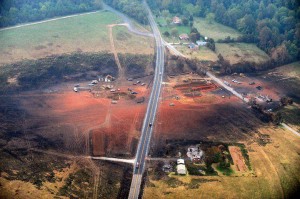Aerial view of the blast site along Virginia 26 in Appomattox County after the September, 2008 natural gas pipeline explosion.
From an Essay by Alden Dudley, Roanoke Times, June 26, 2019
Dudley retired in 2003 as Chief of Staff at the Salem Veterans Affairs Medical Center and Associate Dean at the University of Virginia School of Medicine. From 2003-2010, he was half-time Professor of Pathology at the Edward Via College of Osteopathic Medicine in Blacksburg.
Until 1944, liquid natural gas (LNG) was stored in above-ground tank farms (bulk terminals) as on U.S. 460 in Blue Ridge and off Starkey Road in Roanoke (LNG now under ground).
Cleveland had four LNG tanks above ground in October 20, 1944. One riveted seam leaked cold LNG that flowed down to a sewer with gas and exploded in the sewers at 2:30 p.m. The heat of the first tank fire exploded a second tank 30 minutes later and that exploded the third and fourth in a flash. Half of the energy went north Lake Erie, taking cars and people with it. The other half flattened one square mile of the city to include two factories, 70 homes, and many underground utilities. Manhole covers were found miles away. Just fewer than 200 people were killed, and 600 survivors left homeless. The blast was calculated to be 1/6th of the Hiroshima Atomic Bomb
Our neighbors in Appomattox had the misfortune of a 30” natural gas pipeline with a pressure of 800 pounds per square inch (psi) corroding and exploding on Sept. 19, 2008, with flames more than 300 feet high. That left a hole 20 feet deep and 2,250 feet in diameter (almost one half mile) in farmland. It exploded two houses and damaged 100 others. Williams and Transco Companies were fined $1 million for improper pipeline maintenance. Multiple defects in the 52-year-old pipe were known to exist, but they ignored them.
On Sept. 9, 2010, a 30” natural gas pipe exploded in San Bruno, California, two miles west of the San Francisco Airport. It registered as a 1.1 earthquake, created a rocky hole 40 feet deep, 167 feet long, and 26 feet wide, killed eight people, shot flames 1,000 feet into the air, took 60-90 minutes to cut off the valve, was an eight alarm fire (25 fire engines, four air tankers, and one helicopter with special fire-fighting equipment) that burned for more than 12 hours destroying 38 houses and several streets. Federal inspectors found the pipe to have defective welds, serious erosion, and easily detectable faults that had been ignored. On April 1, 2014 PG&E was found guilty of many safety violations, obstruction of justice, and illegally moving more than $100 million in designated safety funds to executive bonuses.
MVP proposes a 42” natural gas pipeline with twice the capacity of a 30” line to be flowing under 1400 psi, almost twice the pressure in Appomattox. Cut-off valves must be installed every 20 miles leaving gas the volume of Cleveland’s gas. Further, the MVP proposal stipulates Transco will “co-lay” another 42” pipeline to repeat the damage a few nanoseconds after the first pipe blows. We will have had our apocalypse. A hole more than a mile wide. Instant incineration of all adults, children, pets, animals, vegetation, homes, schools, stores, industry, and government offices over an area 3-5 miles in diameter. Dams will be destroyed and lakes gone. Thousands of people will be killed in hill country; tens of thousands if near cities; more than that within cities. Our reputation as an environment-friendly state will never recover. Forget tourists, retirees and breweries that can no longer get potable water. In fact, forget economic development.
This article sounds heretical and outlandish. But certainty of a big bang is predictable. Pipeline companies speak proudly of “only 0.03 percent events per year per thousand miles of pipeline.” At that rate, the 800 mile Trans-Alaska Pipeline should have one leak every three years. By 2006 the pipe thickness was eroded more than 50 percent, shipping of oil was down 50 percent because of pipe weakness, and there were already more than 500 leaks each year, according to the Christian Science Monitor.
By industrial 0.03 percent admitted leaks, the 301-mile MVP line should have only one “event” every ten years. By Alaska Pipeline experience, there should be 188 leaks/year. However, remember that Alaska is under low pressure and Virginia will be under high pressure. Even if there is only one leak/month instead of 15, where would you want it to occur? Franklin County real estate values have already started to decline and home insurance rates to climb. National insurance companies know what happens around pipelines. All of this for a pipeline that is not even necessary.

